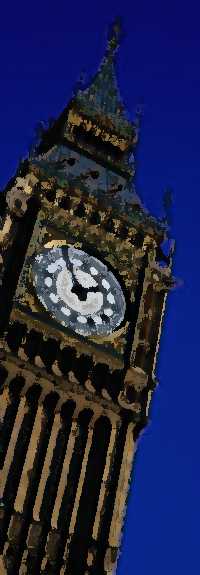| Kwame Nkrumah with Martin Luther King, Jr. |
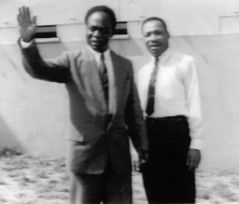
|
| GHANA GOVERNMENT |
| Ignatius Kutu Acheamphong |
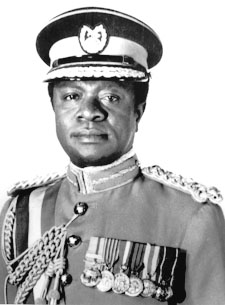
|
| Ignatius Kutu Acheampong (September 23, 1931 June 16, 1979 |
| Fred Akuffo |
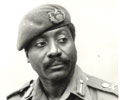
|
| (March 21, 1937 - June 26, 1979 |
| JERRY JOHN RAWLINGS |
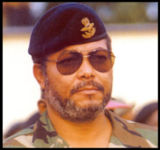
|
History
About Ghana,Culture& Attractions
Ghana (4th - 13th Century): The Republic of Ghana is named after the
medieval Ghana Empire of West Africa. The actual name of the Empire was Wagadugu. Ghana was the title of the kings who ruled the kingdom. It was controlled by Sundiata
in 1240 AD, and absorbed into the larger Mali Empire. (Mali Empire reached its peak of success under Mansa Musa around 1307.)
Geographically, the old Ghana
is 500 miles north of the present Ghana, and occupied the area between
Rivers Senegal and Niger.
Some inhabitants of present Ghana
had ancestors linked with the medieval Ghana.
This can be traced down to the Mande and Voltaic peoeple of Northern Ghana--Mamprussi, Dagomba
and the Gonja.
Anecdotal evidence connected the Akans to this great Empire. The evidence lies
in names like Danso shared by the Akans of present Ghana
and Mandikas of Senegal/Gambia who have strong links with the Empire. There is also the matrilineal connection.
Gold Coast &
European Exploration: Before March 1957 Ghana
was called the Gold Coast. The Portuguese who came to Ghana in the 15th
Century found so much gold between the rivers Ankobra and the Volta that they named the place
Mina - meaning Mine. The Gold Coast was later adopted to by the English colonisers. Similarily, the French, equally impressed
by the trinkets worn by the coastal people, named The Ivory Coast, Cote
d'Ivoire. In 1482, the Portuguese built a castle in Elmina. Their aim was to trade in gold,
ivory and slaves. In 1481 King John II of Portugal
sent Diego d'Azambuja to build this castle. In 1598 the Dutch joined them, and built forts at Komenda and Kormantsil. In 1637
they captured the castle from the Portuguese and that of Axim in 1642 (Fort St Anthony). Other European traders joined in
by the mid 18th century. These were the English, Danes and Swedes. The coastline were dotted by forts built by the Dutch,
British and the Dane merchants. By the latter part of 19th century the Dutch and the British were the only traders left. And
when the Dutch withdrew in 1874, Britain
made the Gold Coast a crown colony.
By 1901 the Ashanti
and the North were made a protectorate...
Britain
and the Gold Coast. The first Britons arrived in the early 19th century as traders in Ghana. But with their close relationship with the coastal people especially the
Fantes, the Ashantis became their enemies...
Economic and
Social Development (Before 1957)
1874--Gold Mine in Wassa and Asante.
Between 1946-1950 gold export rose from 6 million pounds to 9 million pounds.
Political Movements
and Nationalism in Ghana (1945 - 1957)
The
educated Ghanaians had always been in the fore-front of constructive movements. Names that come into mind are --Dr Aggrey,
George Ferguson, John Mensah Sarbah. Others like king Ghartey IV of Winneba, Otumfuo Osei Agyeman Prempeh I raised the political
consciousness of their subjects. However, movements towards political freedom started soon after WWII.
This happened because suddenly people realised the colonisation was a form of
oppression, similar to the oppression they have just fought against. The war veterans had become radical. The myth surrounding
the whiteman has been broken. The rulers were considered economic cheats, their arogance had become very offensive. They had
the ruling class attitude, and some of the young District Commissioner (DC) treated the old chiefs as if they were their subjects.
Local pay was bad. No good rural health or education policy. Up to 1950 the Govt Secondary schools in the country were 2,
the rest were built by the missionaries.
There was also the rejection of African culture to some extent. Some external
forces also contributed to this feeling. African- Americans such as Marcus Garvey and WE Du Bois raised strong Pan-African
conscience.
In 1945 a conference was held in Manchester
to promote Pan African ideas. This was attended by Nkrumah of Ghana, Azikwe of Nigeria and Wallace Johnson of Sierra Leone. The India and Pakistani independence catalysed this desire. Sir Alan Burns constitution
of 1946 provided new legislative council that was made of the Governor as the President, 6 government officials, 6 nominated
members and 18 elected members.
The executive council was not responsible to the legislative council. They were
only in advisory capacity, and the governor did not have to take notice.
These forces made Dr J.B. Danquah to form the United Gold Coast Conversion (UGCC) in 1947. Nkrumah was
invited to be the General Secretary to this party. Other officers were George Grant (Paa Grant), Akuffo Addo, William Ofori
Atta, Obetsebi Lamptey, Ako Agyei, and J Tsiboe. Their aim was Independence for Ghana. They rejected the Burns constitution.
Political History
'Poli' in Latin means
'many' and 'tics' means 'bloodsucking creatures'.
Political highlights
1957 - independence, Nkrumah of CPP is PM, 2 key parties
1960
- declared republic, one party system, presidential system
1966 - military overthrow of 1st republic
1969 - 2nd republic,
Busia of PP is PM, 2 key parties
1972 - military overthrow of 2nd republic
1978 - palace coup to restructure military
government
1979 - junior officer uprising and military housecleaning
1979 - ushered third republic, Limann of PNP is
President, 3 parties
1981 - overthrow of the constitutional PNP gov't by the PNDC military junta
1983 - Attempted overthrow
of the PNDC junta by other junior army men 1992 - Rawlings of NDC is Dem elected as President, 2 parties **
1996 - Rawlings
of NDC is re-elected, 2 parties
2001 - Kuffour (NPP) is President
2005 - Kufuor begins second-term in office
Summary: multiparty system 16 years
military system 21
years
oneparty system 6 years
** fraud allegations led to an electoral boycott resulting
in an effective one party system. Also, marks the first time when the head of a military regime had contested in an election.
Ghana lies at the heart of a region which has been leading
sub-Saharan African culture since the first millenium BC in metal-working mining, sculpture and agriculture.
Modern Ghana takes its name from the ancient kingdom of Ghana,
some 800 km. (500 miles) to the north of present-day Accra, which flourished up to the eleventh century AD. One of the great
sudanic states which dominate African history, the kingdom of Ghana controlled the gold trade between the min- ing areas to
the south and the Saharan trade routes to the north. Ancient Ghana was also the focus for the export trade in Saharan copper
and salt.
The coming of Europeans altered the trading patterns, and
the focus of economic power shifted to the West African coast- line. The Portuguese came first, seeking the source of the
African gold. It lay too far inland for them to reach; but on the Gold Coast they found a region where gold could be obtained,
exported along established trade paths from the interior. Their fort at Elmina ("the mine") was the first in a series of forts
along the Gold Coast designed to repel the other European seafarers who followed in their wake, all struggling for their share
of the profitable Gold Coast trade.
In due course, however, slaves replaced gold as the most
lucrative trade along the coast, with the European slave buy- ers using the forts and adjoining buildings for their own accommodation
and protection, as well as for storing the goods, mainly guns and gunpowder, which they would barter for slaves. Some of the
forts were also used for keeping newly acquired slaves pending the arrival of the ships sent to collect them.
The history of the various forts, given later in this guide,
graphically expresses how the various European trading nations fought for our gold, ivory and later, slaves.
But while Europeans quarrelled over access to the coastal
trade, and despite the appalling depredations of the slave traders, which left whole regions destroyed and depopulated, the
shape of modern Ghana was being laid down. At the end of the 17th century, there were a number of small states on the Gold
Coast; by 1750, these had merged, by conquest or diplomacy, into two: the Asante empire, and the Fantes. By the 19th century,
the Asantes were seeking mastery of the coast, and especially access to the trading post of Elmina. By this time the British
had won control of the coastal trade from the other European nations, and their interests could not tolerate further Asante
expansion - more so since the Asante Empire was known for its sophisticated admin- istrative efficiency and would have been
difficult or im- possible to best at trade. Nevertheless it took a series of military campaigns over some 50 years before
the British were finally able to force the Asantes to give up sovereignty over their southern possessions. In a final campaign
in 1874 the British attempted, without success, to seize Asante; they were however able to take Kumasi and exact a huge ransom
for it in gold; and the vast Asante empire shrunk to the Asante and Brong-Ahafo regions of modern Ghana.
Meanwhile, the Fantes too had been uniting and organiz- ing,
and in 1868 formed themselves into a confederacy under a king-president with a 15,000 strong army, a civil service and a constitution.
In 1871 the British arrested the Fante leaders for "treason". They were however freed a month later, but the con- federacy
never recovered from the blow. In 1874 the British for- mally established the British Crown Colony of the Gold Coast, "legalizing"
a colonial policy which had in fact been in force since the signing of the bond between the coastal Chiefs and the British
in 1844, despite the fact that the Chiefs never ceded sovereignty to the British under the bond, though some of them allowed
British intervention in judicial matters.
The Asante and Fante traditions of education and organ- ization,
and their urge for autonomy, remained throughout the years of British colonial rule. The Gold Coast was regarded as the showpiece
of Britain's colonies: the richest, the best educat- ed, the first to have an elected majority in the legislature and with
the best organized native authorities. The Gold Coast riots in 1948, which marked the start of the people's agitation for
independence, were instrumental in changing British policy and drove home the point that colonialism had no future.
But a long struggle still lay ahead - and the man who was
the catalyst of that struggle was Dr. Kwame Nkrumah
Born in 1909, Dr. Kwame Nkrumah trained as a teacher
at Achimota College in Ghana and then in the United States and Britain, where he obtained his degrees.
He became prominent as a leader of West African organiza-
tions in London and was invited to return to Ghana as general secretary of the United Gold Coast Convention. In 1949 he broke
away to from the Convention People's Party with the slo- gan Self-Government Now.
In February 1951 the party swept to victory in the polls
and became the leaders of Govermnent business in the colony's first African government. The Gold Coast had become the first
British colony in Africa to achieve self-government.
On 6 March 1957 Ghana achieved independence - again, the
first British colony in Africa to do so - with Osagyefo Dr. Kwame Nkrumah as its first Prime Minister. On 1st July,1960 it
became a republic with Kwame Nkrumah as its first President.
Ghana spearheaded the political advancement of Africa and
Dr. Nkrumah laid the foundations for the unity later expressed in the formation of the Organization of African Unity (OAU).
He was a firm supporter of the Commonwealth and the Non-Aligned movement.
On 24th February 1966, the government of Dr. Nkrumah was
overthrown by the Ghana armed forces and the police. A National Liberation Council (NLC), headed by Lt. General Joseph Arthur
Ankrah, was formed to administer the country.
General Ankrah was removed from office in April 1969 and
Lt. General Akwasi Amankwa Afrifa became the Chairman of the NLC, which later gave way to a three-man Presidential Commission
with General Afrifa as chairman. The Commission paved the way for a general election in 1969 which brought into power the
Progress Party government, with Dr. Kofi Abrefa Busia as Prime Minister and Mr. Edward Akufo Addo as president.
The Ghana armed forces again took over the reins of gov-
ernment on 13th January 1972, and Colonel (later General) Ignatius Kutu Acheampong became the Head of State and Chairman of
the National Redemption Council (NRC). The name of the NRC was later changed to the Supreme Military Council (SMC). General
Acheampong was replaced by General F.W.K. Akuffo in a palace coup in July 1978.
The SMC was overthrown on 4th June 1979, in a mass revolt of junior officers and
men of the Ghana armed forces. Following the uprising, an Armed Forces Revolutionary Council (AFRC) was set up under the chairmanship
of Flt.-Lt. Jerry John Rawlings. The AFRC carried out a house-cleaning exercise in the armed forces and society at large,
while restoring a sense of moral responsibility and the principle of accountability and pro- bity in public life. The AFRC
was in office for only three months and, in pursuance of a programme already set in motion before the uprising, allowed general
elections to be held. On 24th September 1979, the AFRC handed over power to the civilian administration of Dr. Hilla Limann,
leader of the People's National Party which had won the elections.
In the wake of the continuing downward plunge of the coun-
try, the Limann administration was overthrown on 31st December 1981, ushering in a new revolutionary era of far-reach ing
reforms and rehabilitation at all levels. Flt.-Lt. Rawlings became the Chairman of a nine-member Provisional National Defence
Ruling Council, (PNDC) with Secretaries of State in charge of the various ministries being responsible to the PNDC .
Immediately on assumption of office, the PNDC set up a National
Commission for Democracy (NCD) charged with for- mulating a programme for the more effective realisation of true democracy.
The Govemment of the PNDC also provided for the establishment of elected District Assemblies to bring local government to
the grassroots.
In 1990, the NCD, at the prompting of the PNDC, organised
forums in all the 10 regions of the country at which Ghanaians of all walks of life advanced their views as to what form of
gov- ernment they wanted. These views were collated and analysed by the NCD whose final report indicated that the people want-
ed a multi-party system of government.
This led to the appointment of a Committee of Experts to
draw up constitutional proposals for the consideration of a Consultative Assembly. The Assembly prepared a draft consti- tution
based on proposals submitted to it by the PNDC, as well as previous constitutions of 1957,1969 and 1979, and the report of
the Committee of Experts. The final draft constitution was unanimously approved by the people in a referendum on April 28,1992.
Among other things, the Constitution provides for an Executive
President elected by universal adult suffrage for a term of four years and eligible for re-election for only one addi- tional
term. In the presidential elections held on November 3, 1992, Flt.-Lt- Rawlings who stood on the ticket of the National Democratic
Congress (NDC), garnered 58.8% of the 3,989,020 votes cast to beat to second place his closest rival Prof. Albert Adu Boahen
representing the New Patriotic Party who polled 30.4% of the votes. Other contestants for the presidency were former president
Dr. Hilla limann of the People's National Convention (6.7%), Mr. Kwabena Darko of the National Independence Party (2.8%) and
Lt-Gen. Emmanuel Erskine representing the People's Heritage Party (1.7%).
In the parliamentary elections held on December 29,1992,
the Progressive Alliance made up of the National Democratic Congress, the National Convention Party and the Egle Party won
198 seats out of a total of 200, within the Alliance the NDC won 189 seats, the NCP had 8, the Egle Party 2, and Independents
2. Four parties - the NPP, PNC, NIP and PHP - boycotted the parliamentary elections, disatisfied with the pro posed election
strategy.
The Fourth Republic was inaugurated on January 7,1993 with
the swearing-in of Flt. Lt. Rawlings as President and his running mate, Mr.K.N. Arkaah as Vice President. The newly elected
Parliament was opened on the same day and elected, Mr. Justice D.F. Annan as Speaker.
1996: Rawlings was re-elected for a second term
In the December 7, 2000 elections, John A. Kufuor of the
New Patriotic Party (NPP), won the largest share of the presidential vote with 48.17% of the vote, compared to 44.54.% for
Rawlings vice-president and hand-picked successor, John Atta Mills of the NDC. The NPP also won 100 of the 200 seats in Parliament.
The NDC won 92 seats, while independent and small party candidates won eight seats. In the December 28 run-off election, with
pledges of support form the other five opposition parties, Kufuor defeated Mills by winning 56.73% of the vote and the NPP
picked up one additional MP by winning a by-election, giving them 100 seats and a majority in Parliament. Both rounds of the
election were observed, and declared free and fair by a large contingent of domestic and international monitors. President
Kufuor took the oath of office on January 7, 2001, becoming the first elected president in Ghanas history to succeed another
elected president. He was re-elected in December 2004 for a second four-year term, becoming the first civilian president (without
a military background) to fully serve his tenure and go ahead to be re-elected.
Political outlook
Under Jerry Rawlings' rule, Ghana became the most
politically stable and prosperous nation in West Africa and provided a model of development for the rest of sub-Saharan Africa.
This may continue under President Kufuor if the new government and opposition remain mindful of the turbulence in neighbouring
Cte d'Ivoire and try to quell some of the grassroots violence seen during the last general election and in Dagbon in 2002.
Political instability and the intervention of the military
is unlikely, particularly given Kufuor's ability to turn the Ghanaian economy around since he came to power. Despite his outbursts,
Rawlings' career as a serial coup maker appears to be over. Nevertheless, following his inauguration in January 2001, President
Kufuor appeared to backtrack on many popular policies which brought him electoral success. Apparently more interested in appeasing
Western donors and international financial institutions than bolstering his own popularity, Kufuor pledged a period of austerity
measures. He claims he is fully aware of the dangers this could pose to Ghana's political stability. In his swearing-in ceremony
he warned that the ailing economy would 'put severe strains on our people's beliefs and enthusiasm for the democratic process'
unless donors step up their assistance.
Culled from the booklet "GHANA - a brief guide" a publication of the Ghana
Information Services Department 1994.
Ghanaweb added more info
I
Ignatius Kutu Acheamphong
He became
Head of State and Chairman of the National Redemption Council (NRC), which was later reformed into a Supreme Military Council,
with Colonel Acheampong (promoted to General) as its chairman. He was deposed in a palace coup on 5 July 1978 and succeeded by the Chief of Defence Staff,
General FWK Akuffo.
Notable
historical changes and events introduced or implemented in Ghana during the period under Acheampong include: the change to
metric system of measurement, change to right-hand drive, "Operation Feed Yourself" (a programme aimed at developing self-reliance
in agriculture), "National Reconstruction" (aimed at promoting employment and skill for workers), face-lift projects in cities,
and the reconstruction/upgrading of stadia to meet international standards.
There
were, however, widespread accusations of both the encouragement and endorsement of corruption in the country under his rule.
Acheampong, together with two other former Heads of State (Gen. Afrifa and Gen. Akuffo) and five other Generals
(Amedume, Boakye, Felli, Kotei and Utuka), was executed by firing
squad in June 1979, shortly after the revolution that brought Flight Lieutenant Jerry Rawlings to power
Kofi
Abrefa Busia
Kofi Abrefa Busia (11 July 1913 - 28 August 1978) was Prime Minister of Ghana from 1969-72. He was born in Wenchi, in
the then British colony of Gold Coast (now called Ghana). He was educated at Methodist School, Wenchi, Mfantsipim School, Cape Coast, then at Wesley College, Kumasi from 1931-32. He later became a teacher
at Achimota Secondary School. He gained his first degree with Honours
in Medieval and Modern History from the University of London, through correspondence during this period.
He gained BA (Hons) at Oxford University
in Politics, Philosophy & Economics; MA. Ph.D.Social Anthropology.
He served as a district commissioner from 1942 to 1949, and was appointed first
lecturer in African Studies. He became the first African to occupy
a Chair at the University of Gold Coast.
In 1951 he was elected by the Ashanti Confederacy to the Legislative Council. In 1952 he
was Leader of Ghana Congress Party which later merged with the other opposition
parties to form the United Party (UP).
As leader of the opposition against Nkrumah, he fled the country on the grounds that
his life was under threat. He later became a Professor of Sociology and Culture at the University of Leiden in the Hague, Netherlands.
He returned to Ghana in March 1966 after Kwame Nrumah's government was overthrown by the military,
and was appointed as the Chairman of the National Advisory Committee of the NLC. In 1967/1968 he served as the Chairman of
the Centre for Civic Education. He used this opportunity and sold himself as the next Leader. He also was a Member of the
Constitutional Review Committee. When the NLC lifted the ban on politics, Busia, together with friends in the defunct UP formed
the Progress Party (PP).
In 1969, PP won the parliamentary elections
with 104 of the 105 seats contested. This paved the way for him to become the next Prime Minister. Busia continued with NLC's
anti-Nkrumaist stance and adopted a liberalised economic system. There was a mass deportation of half a million of Nigerian citizens from Ghana, and a 44 percent devaluation of the cedi in 1971 which met with a lot of resistance
from the public.
While in Britain for a medical check-up, the army under Colonel Ignatius Kutu Acheampong overthrew his government on January 13, 1972. He died from a heart attack in 1978. Along
with J.B. Danquah, Busia's name is associated with Ghana's political right. The New Patriotic Party has claimed the Danquah-Busiaist mantle
in the Fourth Republic
 |
|
 |
|
JERRY JOHN RAWLINGS BACKGROUND
(Retired)
Jerry John Rawlings (born June 22, 1947 in Accra) was twice the president of Ghana. His first presidential
term was acquired through a military coup, while his second was as head of the elected government.
Rawlings
is married to Nana Konadu Agyeman-Rawlings, and has four children- three girls and a boy. He is the joint recipient of the
1993 World Hunger Award. He holds an Honorary
Doctor of Law Degree from Medgar Evers
College, City University of New York and Lincoln University Doctorate
Degree for Diplomacy and Development.
Rawlings was born in 1947, to a Ghanaian mother from Dzelukope, near Keta, in the Volta Region, and a Scottish father. He was educated at Achimota School, but
did not obtain his General Certificate of Education 'O' Level due to disciplinary problems. He enlisted as a Flight Cadet
in the Ghana Air Force in August 1967, and was subsequently
selected for officer cadet training at the Ghana Military
Academy and Training School, Teshie, in Accra.
Hilla Limann
Hilla Limann (December 12, 1934–January 23, 1998) was the President of Ghana from September 24, 1979 to December 31, 1981.
Limann,
whose original last name was Babini, was born in northern Ghanaian town of Gwollu
to a poor family. He managed to gain an excellent education, and took up an academic career. Eventually he became a diplomat,
and served in Switzerland. Following the bloody 1979 coup
led by Jerry Rawlings, Limann, though almost unknown even
in Ghana, was elected President on the
People's National Party ticket. He was an economic moderate, and supported democratic values and Pan-Africanism. He was deposed in a
coup by Rawlings in 1981.
Limann
received 6.7% of the vote as the candidate of the People's National Convention in the 1992 presidential
elections.
Dr. Limann was survived by his wife, Mrs.
Fulera Limann, and seven children: Lariba Montia (neé Limann), Baba Limann, Sibi
Fred Akuffo
Lt. General F.W.K. Akuffo (March 21, 1937 - June 26, 1979) was the Head of the Supreme Military Council (SMC) in Ghana from 1978-1979. He came to power in a military coup, was overthrown in another military coup and executed three weeks later
|
 |
|
| |
|
